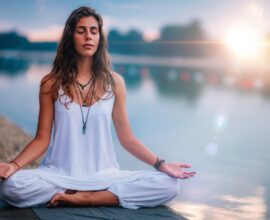Meditation: definition, how to begin and why it’s good for the mind
Meditation: origin and the eight best-known techniques
Meditation is ideal for stimulating psychophysical well-being in an increasingly frenetic and hyper-connected world where it’s easy to give in to stress.
The word Meditation comes from the Latin term meaning “reflection”, it indicates a set of practices focused on relaxing the mind and helping the individual to acquire self-awareness.
Meditation is as old as man and comes from the main religious traditions and Eastern philosophical movements still exerting a strong fascination in Western society.
The earliest reference to the art of meditation was referred to by the Sanskrit term dhyāna meaning literally “vision”, and is found in a set of Indian religious and philosophical texts compiled from the 9th-8th centuries B.C. to the 4th century B.C: the Upaniṣad.
The millennial discipline of yoga includes different styles such as Hatha yoga, Vinyasa yoga and Ashtanga Yoga. The state that is achieved through dhyāna practice favours the experience of enlightenment, namely the revelation of the omnipresent deity.
Patanjali, an Indian philosopher considered the father of yoga, divided the yogic discipline into eight stages and placed the dhyana in seventh place immediately after the Dharana (concentration) and before samadhi (state of grace, perfect communion between the ego and the cosmos).
It’s important to remember there are many techniques of Dharana but there is no real technique of meditation even if among the many methods there are eight more common ones:
1 Zen (or zazen): is the classic Buddhist meditation, the most known and widespread. Breathing and stillness represent the fulcrum of this practice of which the main objective is relaxation of the body and mind. Zen meditation does not translate into an escape from the world but serves to learn how to know yourself, raise awareness, self-control and improve observation capacities.
2 Transcendental: practised by millions of people around the world, transcendental meditation was introduced to the West in the late 1950s by the Indian mystic, philosopher and guru Maharishi Mahesh Yogi. The MT is based on the repetition of a mantra (for example the famous Om), recited for a few minutes twice a day, and the benefits are harmony, a deep sense of tranquillity and inner peace.
3 Vipassanā: Vipassanā is a meditation technique taught by Tathgatha Shakyamuni in the Discourse on the Foundations of Mental Presence (Satipatthanasutta) and consists in several moments: contemplation of the body, contemplation of sensations, contemplation of the mind and contemplation of mental objects. The goal of Vipassanā is to elevate the spirituality of the individual and reach a new vision of life.
4 Mindfulness: the term comes from the word sati which in Pāli language means attention, solicitous attention or full mental awareness. Such awareness can be achieved with a Buddhist meditation technique: Vipassanā meditation. At the base of Mindfulness there are three key concepts: Hit et Nunc, a Latin phrase that means “here and now”, observe and not judge, emotional transparency or analyse actions without any preconception. The goal is to achieve full self-awareness, know the world around us and learn to live the present to ward off pain and reduce stress
5 Ho’oponopono: it is an ancient Hawaiian practise Focused on reconciliation, inner forgiveness, the cancellation of negative thoughts and the resolution of conflicts. It has in common with transcendental meditation the recitation of a mantra but in this case, there is only one formula: “I’m sorry, please forgive me, I love you, thank you”.
6 Walk: the first to use it was Buddha during his tour of India. It is a meditation that, just as the name suggests, is practised by walking and allows you to empty your mind, reorganise your thoughts and regain concentration.
7 Kundalini: is a type of meditative practice that aims to awaken a particular form of energy called Kundalini, a term that comes from the word kundala and means “wrapped” or “rolled up”. This energy is present in every individual, it is found at the bottom of the spinal column and in the latent state, it appears wrapped on itself in three spires like a snake. Each Kundalini session focuses on a specific chakra and aims to awaken or accentuate its benefits. Those who practice this type of meditation can achieve complete and deep well-being accompanied by a great sense of joy and serenity.
8 Dynamic: Zen meditation has a fixed position, meanwhile dynamic meditation exploits movement and frenzy to free the energies of the individual. Dynamic meditation is one of the best known active meditations of Osho Rajneesh, more simply known as Osho, an Indian mystic and spiritual master. This type of meditation is divided into five different stages for a total of 60 minutes, it should be practised in the morning and on an empty stomach. During the practice, it is allowed to laugh, scream, jump and dance to give free rein to the emotions, increase the vital energy and finally get to a stage of calm, quiet and silence.
Meditation: how to start the practice and what are the health benefits
Meditation helps reduce stress, improve the quality of life and is good for body and spirit but it is not an occasional practice and to enjoy the benefits it is essential to be patient and constant. The ideal is to meditate every day for at least 10 minutes, remembering that the depth of meditation is more important than duration.
Continuity is one of the most important aspects of meditation but it is not the only one. Here are ten tips dedicated to those who want to start meditating:
1- the Environment of your practice should be familiar, quiet and relaxing
2- choose comfy, comfortable and breathable clothing
3- preferably sweaters and sweat-pants in natural fibres and soft colours
4- don’t wear accessories, such as bracelets, watches, necklaces or rings which can hinder the movements
5- tye hair in a ponytail if too long
6- sit on a chair or the ground with crossed legs, keeping a relaxed position but with the spine well straight.
7- slightly close your eyes, remain silent and focus on your breath paying attention to how the air flows in and out of your body
8- to increase concentration use a simple mantra as “inhale, exhale” repeating it to yourself in silence or aloud
9- don’t try to fight thoughts that may suddenly arise, welcome them, observe them, and put them aside as you return to focus on your breathing
10- the time devoted to the practice changes from person to person, but for those who have just begun to meditate the ideal are short sessions of 10-15 minutes. When you begin to feel the temptation to stop the practice, it’s advised to not give in to desire but observe the impulse three times and bring attention to your breathing and mantra. The third time stop meditating, open your eyes, start moving slowly and get up.
The benefits of meditation are many and influence the mind, spirit and body. A person who meditates can improve emotional management and stress, have a more efficient concentration ability, have a stronger immune system, sleep well, rebalance and increase vital energy, major pain resistance and serotonin levels, a neurotransmitter known as “good mood hormone” or “happiness hormone”.
Do you want to discover the benefits of meditation and live a wonderful holiday in a true paradise? Discover Forte Village Resort in Sardinia.






